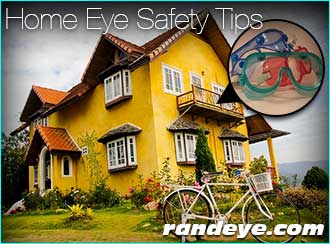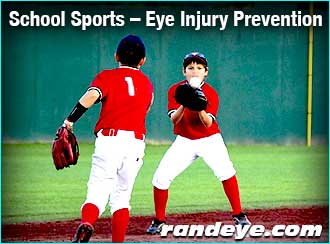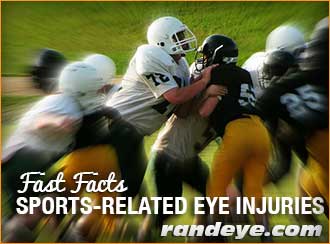Workplace Eye Safety – Common Eye Injuries
There are so many ways you can injure your eyes at work. 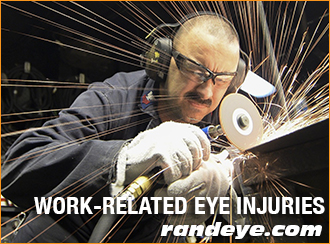
The most common causes for eye injuries are:
• Flying objects
• Tools
• Particles
• Chemicals
• Harmful radiation
Chemical eye burns
Highly acidic and highly alkaline substances are extremely toxic to the eye and can cause chemical eye burns if they come into contact with the surface of the eye.
Alkaline substances pose the greatest risk. These substances are commonly found in workplaces, such as in laboratory chemicals or industrial cleaning products.
Foreign bodies
Small foreign particles such as dust can enter the eye and can cause irritation and inflammation.
Foreign particles such as dust don’t really cause lasting damage to the eyes, but it is very important to remove small particles as to not cause any additional issues.
Blunt trauma
Injuries that do not penetrate the skin and do not result in external bleeding to the eye occur as a result of being struck by a heavy object. They can cause the eye to bleed internally.
Computer use disorders
Using a computer for extended periods of time is associated with a range of temporary eye disorders including pain and discomfort.
Eye diseases associated with excess UV exposure.
Outdoor workers are exposed to ultraviolet radiation in the form of sunlight, excessively. Artificial sources of ultraviolet radiation are also found in a range of workplaces and is also damaging to the eyes. These include welding arcs, germicidal lamps and lasers.
Holiday Season Eye Safety Tips
This holiday season eye safety may not be your foremost concern. However, this time of year can be dangerous for your eyes due to toys, sports and other potential hazards. Here’s how you can protect your precious sight during the holidays. 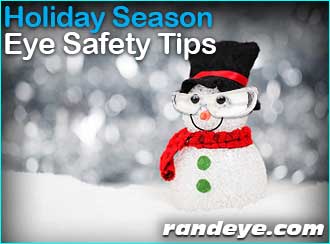
Christmas Tree Tips:
Who would think the eye-catcher and focal point of the season, the Christmas tree, could be the very thing to cause you injury? Christmas tree injuries are very common, and should be addressed.
- Wear eye-protective wear when cutting your tree.
- Hang glass ornaments out of reach for small children.
- Do not put gifts too far under the tree for small children.
- Be careful around the tree, especially when reaching for gifts to not be hit in the eye with a branch.
Toy Tips for Parents:
Children are so excited to open their gifts and play; the last thing on their mind is eye safety. Unfortunately, toy-related eye injuries are at an all time high in the holiday season according to the Consumer Product Safety Commission. Most of the injuries are preventable.
- Supervise children with new toys they may not be used to operating.
- Avoid buying toys with sharp edges or projectile parts.
- Choose toys based on child’s age but most importantly, their maturity level.
- Explain proper use of toys to children before allowing them to find out alone.
Ready to Pop Champagne and Celebrate:
Social gathering, spreading the holiday cheer sounds like the ultimate plan. Adults, when ready to pop the champagne remember to be careful. No one wants to be hit in the eye with the cork.
- Remember to hold the cork down firmly with the palm of your hand while removing the wire.
- Use a towel and point it away from yourself and others.
- Keep the bottle at a 45-degree angle.
- Hold the cork down with the palm of your hand while you remove the wire hood.
Snow Glare while Driving:
Although, our Floridian patients do not need to worry about this, if you are traveling and driving in the snow always be cautious.
It is a misconception that sunglasses are only needed in the summer.
- Wear sunglasses with polarized lenses
- Keep windshield clean for smudges and particles that can distract clear vision on the road.
The holiday season is a joyous time of friends, family and food. Lets keep it that way by paying close attention to these eye-safety tips.
Preventing Toy Related Eye Injuries
The holiday season is finally here! 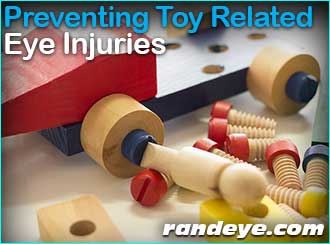
As we gather with friends, family and loved ones it is important that we factor in their safety to help promise a safe, happy time.
No one chooses gifts with the intent to cause harm, but what many people do not realize when purchasing some popular children’s toys, is that is what can happen.
Each holiday season, toys and sporting equipment, that were meant to bring joy, are actually responsible for thousands of eye injuries to children?
But do not let that ruin the holiday spirit. These eye injuries are totally preventable!
Parents can keep their children safe by demonstrating the proper use of toys, purchasing age-appropriate toys and supervising them while in use.
Safe Toy Checklist:
- Read all warnings and instructions.
- Make certain children wear appropriate eye protection for sports (face shields, helmets).
- Avoid toys with sharp or rigid points, spikes, or projectile-firing parts.
- Inspect toys for safe, sturdy construction. Toys should be durable and able to withstand impact.
- Look for the letters “ASTM” which means the toys met the national safety standards set by the American Society for Testing and Materials.
- Repair or replace damaged or defective toys.
- Try not to purchase flying toys. Bows, arrows, slingshots, and darts can be extremely dangerous.
- Check for age labels on the toys and be sure to choose toys that are appropriate for a child’s age and maturity.
- Do not give toys with small parts to young children. They tend to put them in their mouths, increasing the risk of choking.
Halloween Eye Safety
The month of October has brought out cool air, falling leaves and a few ghost and goblins! With Halloween approaching, safety seems to be the key component that parents are considering when planning out the night. Luckily, there is a lot we can do to prevent our Halloween night from turning into a disaster. 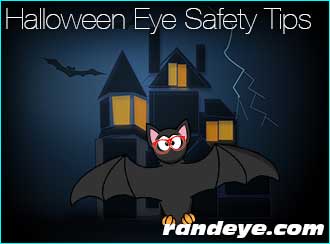
Typically parents and children should inspect all candy before eating and walk through their neighborhoods at night using flashlights and reflective clothing.
Another important area to consider on Halloween is eye safety.
Before selecting your holiday costume, take into consideration a few of these eye safety tips to ensure a fun, safe and spooktacular Halloween!
Avoid costumes that block vision
Masks, wigs and eye patches can help polish off a Halloween costume, but make sure they don’t obstruct your field of vision. Some masks can be very dangerous for children, because they block their side vision.
Use makeup and face paint properly
If you do decide to disguise your child’s face with makeup instead of a mask, opt for a hypoallergenic option and always check for FDA approval. Keep the makeup away from the eyes. It would be a good idea to keep a damp towel or washcloth in case makeup begins to run while out.
Don’t use sharp objects as props
Some costumes just don’t seem complete without a sword or wand. When choosing accessories for your child’s costume, make sure they are age appropriate and don’t pose any harm. It is best to avoid sharp, pointed props, all together.
Don’t use decorative contacts that were not prescribed by doctors
Buying any kind of contact lens without an examination and prescription from an eye care professional can be extremely dangerous. It can lead to serious eye disorders and infections, which can even lead to permanent vision loss.
It is also against federal law to sell contact lenses in an unlicensed outlet, such as a costume shop, party store and beauty supply stores. They may be made from inferior plastics or contain toxic dyes.
Carry a flashlight
Give your child a small flashlight to illuminate dark paths and walkways. In low light areas, your child will not be able to see potential hazards like uneven pavement or holes, which are tripping hazards. Flashlights will also make your child more visible to drivers.
It is also a good idea to keep porch and stairways clear and illuminated.
We hope these tips keep you safe during your Halloween adventures!
Home Eye Safety Tips
Our homes are relatively safe places to be, but sometimes accidents do happen. Whether it’s a botched do it yourself project or something as simple as working in your garden, mistakes are prone to occur.
Some common eye injuries, such as deep puncture wounds from accidents, could require immediate treatment or surgery to prevent any permanent damage to the eye that could result in vision loss.
Other injuries such as minor surface scratches may not be as serious.
Here is a guide to follow, to help you determine what to do next in the case that an accident to the eye may occur:
- Scratched Eye (Corneal Abrasion)
Some common causes of abrasions to the eye’s surface include getting poked or rubbing the eye when a foreign body is present, like dust or sand. This can cause red eyes and sensitivity to light.
If something has gotten into your eye, it is important to see your eye doctor or visit an ER.
Scratches to the eye make them more prone to infections from bacteria or fungi. Certain types can enter the eye through a scratch and cause serious harm very quickly.
If you have a scratch to the eye, do not rub it or patch your eye up. Simply keep the eye closed, see your doctor as soon a possible.
- Penetrating/ Foreign objects in the Eye
If a foreign object such as metal enters your eye, visit the ER or urgent care center immediately. You may cause even more harm to your eye, if you try to remove the object by yourself, or if you rub your eye.
- Chemical Burn to the Eye
Getting unexpectedly splashed in the eye by a substance other than clean water can be a very serious thing. Some substances, although they might burn or sting, can be fairly harmless, while others can cause extreme injuries.
Acid: Can cause redness and burning, but can be washed out easily.
Alkali: This is a much more serious case, but might not seem that way because they do not cause much immediate eye pain or redness like acids do.
Call your eye doctor or an emergency room/urgent care center to see what is recommended for your eye injury. Let them know exactly what kind of substance got into your eye, so they assist you on what steps to take next.
If your eye becomes extraordinarily red or blurry, head to your eye doctor immediately after you’ve rinsed it with water. You can put a cool, moist compress or an ice pack on your eye, but make sure you don’t rub it.
- Eye Swelling
Eye swelling and puffy eyelids can be the result of being struck in the eye by an object. The best, immediate treatment for this type of injury is an icepack to the eye.
Even though it may be something as simple as a black eye, you should see an eye doctor to make sure there’s no internal damage.
Home Eye Safety Month
You might think your family home is a fairly safe and unthreatening place, what you didn’t know is that your home is a very common place to suffer from eye injuries! More than half of the reported eye injuries occur in the comfort of your own home!
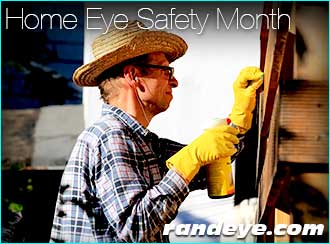
Eye Injury Risk in the House
- Using hazardous products and chemicals such as oven cleaner and bleach for cleaning and other chores. (Accidents involving common household products cause 125,000 eye injuries each year).
- Splattering hot grease and oil while cooking.
- Opening champagne bottles during a celebration.
- Drilling or hammering nails into the walls or other hard surfaces ( the screws/nails can become projectiles or fragments can come off the surface.
- Using hot objects such as curling irons around the face.
- Loose rugs and railings that could potentially cause slips or falls.
Injury Risk in the Yard
- Mowing the lawn.
- Clipping hedges and bushes.
- Debris of dust or falling trees, branches.
Eye Injury Risks in the Garage or Workshop
- The use of tools (power or hand).
- Working with solvents or other chemicals.
- Ding any task that can produce fragments, dust particles or other eye irritants.
- Keep in mind, bystanders also face a significant risk and should also take part in the necessary precautions to prevent injuries to the eye.
Remember to always wear eye protection and use equipment in a safe manner.
School Sports – Eye Injury Prevention
There is nothing worse than getting a phone call from your child’s school informing you of an injury. Most of those injuries occur to the eye during gym class. This year, avoid those phone calls and send your child to gym class prepared!
In order to prevent injuries, children should wear the appropriate sports eye protectors that are made with polycarbonate lens for baseball, basketball, football, racquet sports, hockey, etc.
The eye protection needed to prevent eye injuries in your sport is determined by a few various standards that are set by the American Society for Testing and Materials (ASTM).
The eye-safety standards go by the following:
- ASTM F803: Eye protectors for selected sports (racket sports, women’s lacrosse field hockey, baseball, basketball)
- ASTM F513: Eye and face protective equipment for hockey players;
- ASTM F1776: Eye protectors for use by players of paintball sports;
- ASTM F1587: Head and face protective equipment for ice hockey goaltenders
- ASTM F910: Face guards for youth baseball
—- Prescription lenses can also be fitted into some types of sports eye protectors, as well.
Gym class is not the only time your children’s eyes could be at risk. Students are advised to always wear the appropriate protective glasses in shop class or while doing science labs. Talk to your child’s school to ensure the correct protective eyewear is being used.
Children Eye Health – Vision Warning Signs
It’s August and summer vacation is winding down, and students are preparing for another school year. This year, don’t forget to check an annual eye exam off their to do lists.
It is important to have your child’s eyes tested, because it can lead to greater success in the classroom because much of a child’s learning occurs visually.
Have you noticed any change in your child’s vision? Here are some signs and behaviors you can watch for that may indicate a child is struggling with his or her vision.
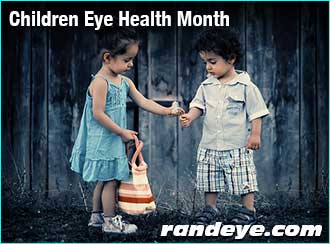
What does your child’s eyes look like?
• Eyes don’t line up, one eye appears crossed or looks outward;
• Eyelids are red-rimmed, crusted, or swollen; or
• Eyes are watery or red (inflamed).
Is Your Child Doing Any of the Following?
• Rubs eyes frequently;
• Closes or covers one eye;
• Tilts head or thrusts head forward;
• Has trouble reading or doing other close-up work, or holds objects close to eyes to see;
• Blinks more than usual or seems cranky when doing close-up work; or
• Squints eyes or frowns.
Does Your Child Say Any of the Following?
• “My eyes are itchy,”
• “My eyes are burning,”
• “My eyes feel scratchy,”
• “I can’t see very well”
• After doing close-up work, your child says, “I feel dizzy,” or “I have a headache,”
• “Everything looks blurry,” or “I see double.”
It is recommended that your child has annual eye exams, to screen for any abnormal changes in vision.
Happy Independence Day – Eye Safety
As the fourth of July celebrations usually include fireworks, we urge you to celebrate with caution.
Fireworks injure over 9,000 people a year, and 47% of those people were just bystanders. The safest way to enjoy fireworks for this upcoming 4th of July is to remain at least 500 ft. away from where the fireworks are being lit.
Children are frequent victims of firework related injuries: 30 percent of those who have sustained a fireworks injury near the Fourth of July holiday are age 15 and under.
If you or someone else are setting off fireworks you should follow safety tips:
- Make sure the person lighting the fireworks has protective eyewear.
- Make sure they never try to relight a “dud” firework.
- Make sure only one firework is being lit at a time, never attempt to light more than one.
- Never aim a firework at a person, pet, vehicle, house, or any structure or something flammable.
- Always keep a supply of water or fire extinguisher near by at all times as a safety precaution.
- When storing fireworks, keep them in a cool, dry and safe place, away from children and pets.
- Lastly, one should leave the area where the fireworks are being shot off from, unless it is a trained professional, in which case one should remain at least 500 ft. away.
If you are injured from fireworks:
- Seek medical attention right away.
- If any particle enters your eye, don’t touch or rub it.
- Do not rinse your eyes.
- If a sharp object enters your eye, do not pull it out. Carefully place a loose bandage on the eye and do not apply pressure.
- Do not take any blood-thinning medication such as aspirin.
Stay safe this holiday, and have fun!
Fast Facts About Sports Related Eye Injuries
Sports Related Eye Injuries – Common Facts
- An estimated 40,000 sports-related eye injuries occur each year in the United States.
- 13,500 people go blind due to sports-related eye injuries.
- 90 percent of sports-related eye injuries could have been prevented.
- One-third of people who suffer from sports-related eye injuries are children.
- The most common consequences of sports-related eye injuries are abrasions, contusions, detached retinas, corneal lacerations, cataracts, hemorrhages and loss of an eye.
- Water and pool sports such as diving, swimming and water skiing collectively, make up the second leading cause of sports-related eye injuries.
- Paintball has become a popular sports worldwide, but as bee noted with devastating eye injuries, including blindness.
- In the NFL, facemasks fitted with shields are specially contoured according to the player’s position, to help further prevent injuries.
- There was a ninety-percent decrease in ocular trauma after certified full-face mask became mandatory in organized amateur hockey, in Canada.
- Polycarbonate lenses provide the best eye protection for many sports. They are lightweight, scratch resistant, thin, and can be designed to meet most eyewear designs or prescriptions.
- Polycarbonate is 10 times more impact-resistant than other plastics and can withstand the force of a .22-caliber bullet, which is why it is the best for eye protection.
Remember to always use the proper eye protection equipment for your particular sport.

